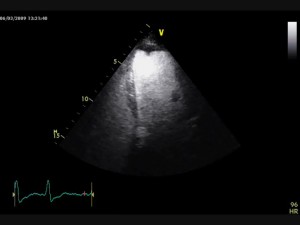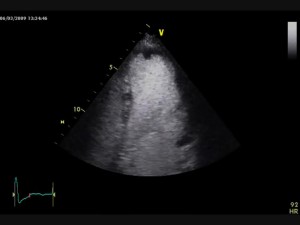Blooming describes a phenomenon, that ultrasound signals due to high concentration of contrast medium outshine adjacent weaker signals, similar to an over-exposure in photography. Blooming can hamper the assessment of a ventricular thrombus or the detection of a perfusion signal from the endocardium during a stress test. It also means that vessels in the myocardium appear greater than their corresponding anatomical size.
|
blooming artifact: a high concentration of contrast bubbles in the apex produces a kind of “over-exposure” with outshining the weaker signals from the subendocardium and the apical thrombus. |
If the concentration of the bubbles decays, the blooming artifact resolves.
|
Blooming is influenced by the dose and the velocity of influx of the contrast medium. In normal cardiac output, it is often sufficient to let the patient breathe deeply several times to increase the venous return and to support the influx optimally.
With reduced cardiac output, a slowly injected bolus of 2-3 ml 0.9% NaCl – solution can accelerate the influx of contrast in the left ventricle.
If a blooming artifact appears, wait a few seconds up to a minute, until the concentration has been reached a level for an optimal picture. Ultimately, this is an uneconomical use of the contrast agent. Re-injection may subsequently take place with 0.5 ml of 0.3 ml.
Blooming occurs even when using a contrast agent pump, for example during a stress echocardiography. For other contrast agents use correspondingly different dosages.


